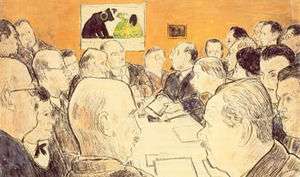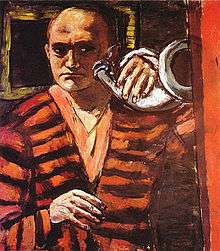Berlin Secession


The Berlin Secession (German: Berliner Secession) was an art association founded by Berlin artists in 1898 as an alternative to the conservative state-run Association of Berlin Artists. That year the official salon jury rejected a landscape by Walter Leistikow, who was a key figure amongst a group of young artists interested in modern developments in art. Sixty-five young artists formed the initial membership of the Secession.
Max Liebermann was the Berlin Secession's first president, and he proposed to the Secession that Paul Cassirer and his cousin Bruno act as business managers.
In 1901 Bruno Cassirer resigned from the Secession, so that he could dedicate himself entirely to the Cassirer publishing firm. Paul took over the running of the Cassirer gallery, and supported various Secessionist artists including the sculptors Ernst Barlach and August Gaul, as well as promoting French Impressionism and Post-Impressionism.
The biggest conflict in the Berlin Secession was over the question of whether it should follow the new wave of Expressionism.
Notable members
- Hans Baluschek (1870–1935)
- Ernst Barlach (1870–1938)
- Paul Baum (1859–1932)
- Max Beckmann (1884–1950)
- Charlotte Berend-Corinth (1880–1967)
- Josef Block (1863–1943)
- Martin Brandenburg (1870–1919)
- Erich Büttner (1889–1936)
- Lovis Corinth (1858–1925)
- Anna Costenoble (1863–1930)
- Charles Crodel (1894–1973)
- Ludwig Dettmann (1865–1944)
- Otto Heinrich Engel (1866–1949)
- Lyonel Feininger (1871–1956)
- Philipp Franck (1860–1944)
- August Gaul (1869–1921)
- Robert Genin (1884–1941)
- Hugo von Habermann (1849-1929)
- Karl Hagemeister (1848–1933)
- Philipp Harth (1885–1968)
- Emil van Hauth (1899–1974)
- Erich Heckel (1883–1970)
- Franz Heckendorf (1888–1962)
- Curt Herrmann (1854-1929)
- Adolf Eduard Herstein (1869-1932)
- Dora Hitz (1856–1924)
- Ferdinand Hodler (1853–1918)
- Ulrich Hübner (1872–1932)
- Willy Jaeckel (1888–1944)
- Franz M. Jansen (1885–1958)
- Ernst Ludwig Kirchner (1880–1938)
- Fritz Klimsch (1870–1960)
- Max Klinger (1857–1920)
- Wilhelm Kohlhoff (1893–1971)
- Georg Kolbe (1877–1947)
- Käthe Kollwitz (1867–1945)
- Leo von König (1871–1944)
- August Kraus (1868–1934; 1911–13 vice president)
- Bruno Krauskopf (1892–1960)
- Max Kruse (1854–1942)
- Walter Leistikow (1865–1908)
- Max Liebermann (1847–1935)
- Heinrich Eduard Linde-Walther (1868–1939)
- Otto Modersohn (1865–1943)
- Marg Moll (1884–1977)
- Oskar Moll[1] (1875–1947)
- George Mosson (1851–1933)
- Edvard Munch (1863–1944)
- Emil Nolde (1867–1956)
- Ernst Oppler (1867–1932)
- Emil Orlík (1870–1932)
- Waldemar Rösler (1882–1916)
- Max Schlichting (1866–1937)
- Karl Schmidt-Rottluff (1884–1976)
- Ernestine Schultze-Naumburg, later Ernestina Orlandini (1869–1965)
- Clara Siewert (1862–1945)
- Renée Sintenis (1888–1965)
- Franz Skarbina (1849–1910)
- Maria Slavona (1865–1931)
- Max Slevogt (1868–1932)
- Eugene Spiro (1874–1972)
- Robert Sterl (1867–1932)
- Adolf Strübe (1881–1973)
- Wilhelm Trübner (1851–1917)
- Lesser Ury (1861–1931)
- Max Uth (1863–1914)
- Arnold Waldschmidt (1873–1958)
- Karl Walser (1877–1943)
- Emil Rudolf Weiß (1875–1942)
- Hedwig Weiß (1860−1923)
- Julie Wolfthorn (1864–1944)
- Heinrich Zille (1858–1929)
Gallery
-

Max Liebermann: Allee in Overveen
-
Lesser Ury: Cafe Bauer
-

Lovis Corinth: In the slaughterhouse
-

Max Slevogt: Nini am Weinspalier
-

Ernst Oppler: Der Maler und Jo
-

Paul Baum: Spring
-
1908.jpg)
Emil Nolde: Garden of flowers
-

Emil Orlik: Unknown woman, 1917
-

Max Beckmann: Self-portrait with Horn, 1938-1940
Notes
- ↑ Siegfried & Dorothea Salzmann: Oskar Moll – Leben und Werk, München 1975, S. 63;
Oskar Moll – Gemälde und Aquarelle, Ausst.-Kat, Landesmuseum Mainz, Mainz 1997, Michael Kirchner, Chronologie zu Leben und Werk, S. 9
References
- Paret, Peter: The Berlin Secession. Modernism and its enemies in Imperial Germany, Harvard University Press 1980
External links
 Media related to Berlin Secession at Wikimedia Commons
Media related to Berlin Secession at Wikimedia Commons